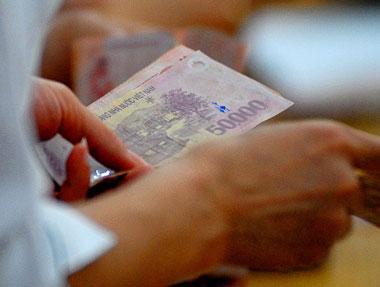
| Dong depreciation said to require urgent action | |
A leading economist, National Assembly deputy Tran Du Lich, says high inflation and a depreciating dong are both big threats to Vietnam’s economy, but gives priority to stabilizing the exchange rate. The State Bank of Vietnam reports that outstanding credit on 30 October was 33.29 percent more than at the end of 2008, while the growth in outstanding loans has been eight times faster than the economic growth rate.
In other words, results have been considerably worse than official predictions, raising concern that high inflation may again be just around the corner. As recently as early September, the Government hoped to hold credit growth to 30 percent for the full year.
The rapid credit growth rate is inevitable, says Tran Du Lich, former Head of the HCM City Economics Institute and now a member of the National Assembly’s Economics Committee under the National Assembly. Lich told that Vietnam cannot tighten credit because a loose monetary policy is necessary to pump up the national economy.
Lich admits that if the total credit growth rate in 2009 approaches 40 percent, there will be a high risk of an inflationary burst. He warns that scheduled disbursements for public investment projects towards the year end will put even more money in circulation
The noted economist points to assymetry between the high credit growth rate and GDP that is expected to reach only 5.2 percent in 2009. The nation has had
to increase credit by nearly eight dong to obtain additional economic growth of one dong, he said, and this is an overly high ratio compared to other regional countries.
A recent State Bank report to the National Assembly said that the ratio Vietnam’s credit growth to GDP growth has averaged 3.85 in previous years. In other regional countries, only Indonesia (a 3.32 ratio) rivals Vietnam, while the ratios are barely above 1:1 in other countries. “The high ratio shows low efficiency of capital use in Vietnam,” Lich says, “and the pressure on inflation is obvious.”
Finance and banking expert Doan Huu Tue is worried about loan quality. He calls the 33 percent credit growth rate to date not so worrisome, and warns that Vietnam ought to be on the alert against a bout of high inflation.
Tue said that in the economic downturn period, Vietnam has had to employ economic stimulus package and grow the money supply. Therefore, it is understandable to see higher than usual credit growth. Nevertheless, credit growth on the order of forty percent cannot but create inflationary pressures.
Tue said that controlling credit quality is therefore an urgent task. If capital cannot be used efficiently, Vietnam’s competitiveness will deteriorate. He hopes the SBV is correct that bad debts can be held to less than three percent of outstanding loans.
Lich calls curbing inflation “next year’s problem.” First Vietnam needs deal with a deteriorating exchange rate. He said the central bank’s report underscores Vietnam’s high foreign debt ratio of Vietnam. The need to service growing foreign debts, whether they are the Government’s or businesses’, will put pressure on the exchange rate. “The biggest task for now is to stabilize the exchange rate,” Lich said.
He went on to say that there’s every reason to worry about that. All the four sources of foreign currency revenues (exports, foreign direct investment (FDI) disbursements, revenue from tourism and overseas remittances) will see decreases in 2009. Despite a lot of exertion, the trade deficit looks to reach USD12 billion this year. | |
| VietNamNet + TBKTVN |
